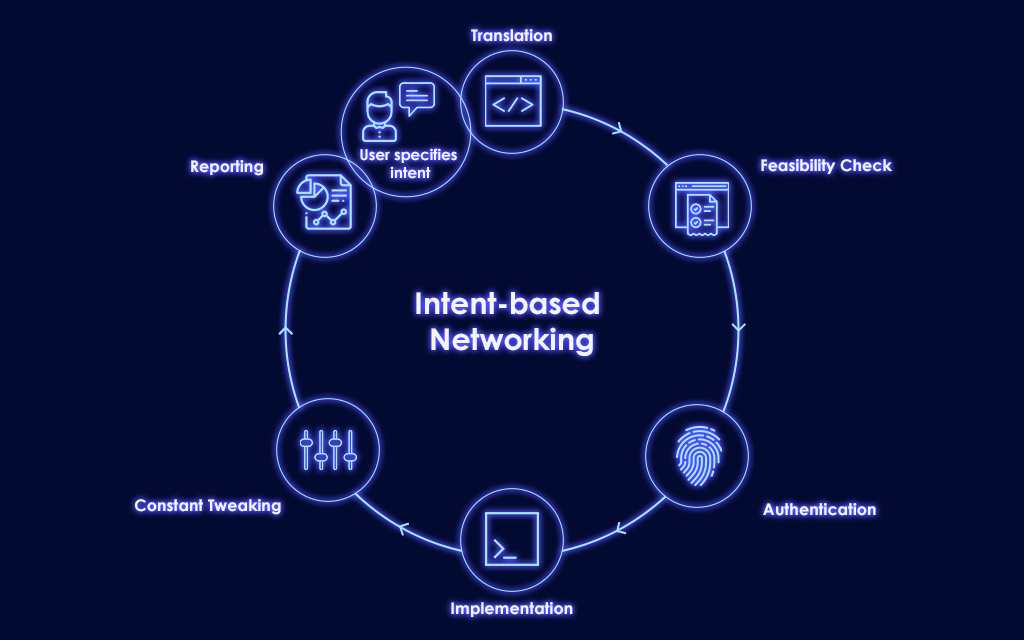Intent-based networking is networking technology that configures the entire IT infrastructure based on the business intent — a service request from the network administrator without any human intervention. In a nutshell, it is the use of technology to eliminate manual configuration of the network. The employed technology continuously provides critical network insights and constantly tweaks the hardware configuration to ensure the intent is met.
Intent based networking system takes networking from a device-centric to a business-centric model. Intent-based networking (IBN) leverages the analytics of machine learning (ML) with the power of IT automation to enhance the agility of the IT infrastructure in every possible aspect. In simple terms, IBNS is a self-driving networking system.
The Intent based networking system has a lot to offer organizations, including:
Managing hardware in the thousands with network automation can drastically reduce the mean time to repair (MTTR). It makes the IT infrastructures flexible, helping IT administrators handle complex service requests with fewer resources. The intent based networking platform saves time and resources for businesses, which are important factors for all enterprise-grade organizations to consider.
Here are some of the advantages of intent-based networking.
An IBNS works on four basic principles.
Translation of intent: The business intent is translated into a policy (configuration change) that is an actionable service request.
Implementation of policies: The network administrator approves the new policy and it is implemented by software.
Continuous data analysis: The IBNS audits the network infrastructure for faults and performance.
Assurance by real-time reporting: The IBNS reports on the performance with critical network insights.
Let's consider an educational institution that offers off-campus learning courses to its students. The institute broadcasts a lecture for a specific course from 10am to 11:30am on the third Wednesday of every month. For the lecture to broadcast without intermittent issues, the organization must do two things during the lecture:
The IBNS breaks down the service request into actionable tasks:

The IBNS comes in handy for the network administrators when dozens of service requests have to be handled. The above mentioned example covers only some of the capabilities of the IBNS.
The idea behind intent based network management has been around for years, just as SDN. Though the two technologies graze one another in numerous aspects, they differ by their fundamental ideas.
A software-defined network (SDN) is an IT infrastructure in which all hardware is configured by a central software console. An SDN aims at controlling the IT infrastructure with the help of software applications but an SDN operates on a device-centric model such as exporting flow data from a specific interface.
The goal of IBN is to create an autonomous network. IBN needs only the business intent. So it can frame and enforce policies, configure the network accordingly, and constantly check and tweak the network performance. Leveraging the cognition of machine learning with network orchestration is IBN's unique selling proposition (USP). Above all, IBN operates on a business-centric model.
SDN primarily works on how a device should operate. On the other hand, IBN works on how to achieve the service request — intent by automatically identifying resources and configuring them.
Since the IBNS is not a proven technology, there are a lot of challenges that might be encountered when employing it. Some of them are:
Visibility: The most important factor to consider is visibility into the network. If software fails to deliver as promised, identifying the network hogs won't be a picnic, since the policies are enforced by the software itself.
Reliability: Though the IBNS enforces policies after validation from network administrators, there will always be the concern of reliability. What if the policies do not yield peak performance for the specified intent? The process has to be started all over. Now imagine starting over an IT infrastructure containing a thousand devices...scary, right?
The IBNS is gaining traction in the networking industry and hence make your IT infrastructure more agile starting today with ManageEngine OpManager.
ManageEngine OpManager is a comprehensive network monitoring system that proactively monitors servers, switches, routers, firewalls, and anything that has an IP and is connected to the network. Gain 360° network visibility with complete
OpManager's code-free workflow automation feature helps in efficiently managing your IT infrastructure, making it more flexible to service requests. With the Network Configuration Manager add-on, the above discussed example can be executed in OpManager with a drag-and-drop workflow builder.
The Network Configuration Manager configlet (configuration template) is scheduled at 9:45am on the third Wednesday of every month. The configlets will modify the network devices and broadcast hardware configurations accordingly. Similarly, another configlet (this time, reverting the above changes) is scheduled at 11:45am on the third Wednesday of every month. SMS and Slack notifications can be added to the workflow to confirm the configlets are pushed in a timely manner. You can push and revert configurations without any user intervention on a regular basis with ManageEngine OpManager. Email and slack notifications can both be added.
Try your hands on ManageEngine OpManager's 30 day free trial and manage your IT infrastructure efficiently starting today!
More than 1,000,000 IT admins trust ManageEngine ITOM solutions to monitor their IT infrastructure securely